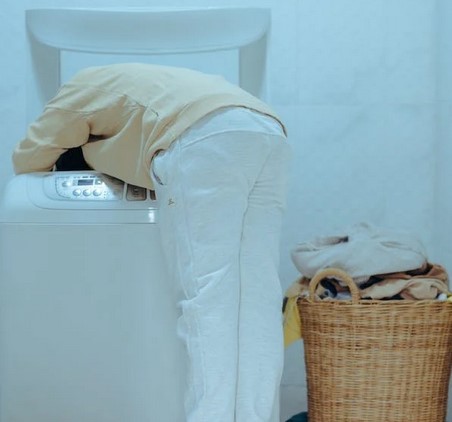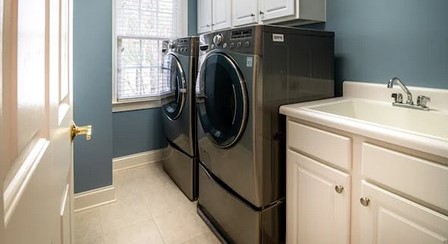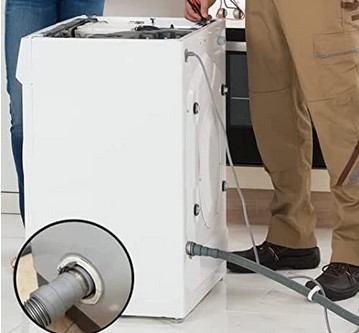We all worry about the washing machines’ wastewater flowing back and contaminating the rest of the water, and in consequence, the idea of installing a backflow preventer may arise. But frankly, does a washing machine need a backflow preventer?
Since washing machines have anti-backflow built-ins and drain directly into the sewer line through standpipes, they don’t require backflow preventers. However, given that these options are not 100% effective, you are more likely to prevent backflow with a backflow preventer than without it.
So, it’s not a matter of preference but purpose. You don’t install a backflow preventer because you feel like it but because of what it promises, and that’s stopping wastewater from backing up.
In some states, however, installing a backflow preventer such as a check valve or air gap is an essential requirement on washing machines, which means you’ve no option but to oblige.
Well, look at why you may or may not need a backflow preventer, the various backflow prevention options, and the pros and cons of installing backflow preventers. But first, let me explain the terms backflow and backflow preventers.

What’s Backflow and What Causes It?
Backflow refers to the reverse flow of discharged water. Wastewater from your washing machine shouldn’t go back, and when it does, we use the term backflow or sometimes backing up.
Generally, here are the two causes of backflow on washing machines:
- Back Siphonage – A Back Siphonage occurs when the pressure drops in the drain hose, forcing the discharge water to flow back in the opposite direction. The issue is likely to happen when there’s an interference in the main water supply line.
- Back Pressure – The wastewater pressure shouldn’t surpass that of the inbound water. If it does, it may cause backflow, and we use the term back pressure in such a case.
What’s A Backflow Preventer?
As the name suggests, a backflow preventer is a simple device that stops backflow. This device only allows one direction flow, meaning wastewater from your washing machine won’t flow back once it flows through the backflow preventer.
Here are the most typical types of backflow preventers:
- Check valves – Check valves or non-return valves allow water to move in one direction, depending on the pressure difference. Once the pressure increases, the valve opens, and when it drops, the valve shuts to prevent backflow.
- Air gaps – Air gaps are popular among dishwashers, and they work by creating an air gap seal that stops backflow.
- Atmospheric vacuum breakers (AVB) – AVBs are popular on drain hoses and faucets and depend on pressure difference to open and close.
So, Does A Washing Machine Need a Backflow Preventer?
Since you now know what backflow preventers are and how they work, you may wonder if you need them. Well, here’s what you should know:
Why A Backflow Preventer May Not Be Necessary
There are two reasons a backflow preventer installation is unnecessary, and they are as follows:
1. Washing machines have anti-backflow built-ins
Most washing machines are designed with an anti-backflow feature which removes the need to install a backflow preventer. Their job is to promote one-direction water flow and stop backflow.
2. Washing machines may only need a properly installed standpipe
Typically, washing machines drain into the sewer line via the standpipe. In that case, if you live in a municipal or city setup where all households discharge water to drain into the main sewer line, you wouldn’t have to worry about installing a backflow preventer.
You must ensure that the standpipe that connects the washer’s drain hose and the sewer line is installed correctly. If wrongly installed, the water may flow back, as I explain next.

When Do You Need a Backflow Preventer?
Let’s face it, the two reasons shared above can be compromised. For one, the washing machine’s anti-backflow built-in may fail; when it does, wastewater could flow back into the washer or your supply tank.
Secondly, the standpipe may fail if it’s wrongly positioned or clogged. So, you need an alternative, and that’s where a backflow preventer comes in.
Generally, you need a backflow preventer in case:
- The anti-backflow built-in fails
- The standpipe is wrongly installed, thus defective, or clogs up
Let’s discuss the pros and cons of installing a backflow preventer.
Pros of a Washing Machine Backflow Preventer
Here are the notable advantages of fitting backflow preventers on washers:
- Water purity – Since backflow preventers stop contaminated water from flowing back, they keep your laundry water clean. In that case, you wouldn’t have to worry about washing with dirty or contaminated water.
- Water safety – By preventing backflows, backflow preventers stop microbes and toxic chemicals from flowing back and contaminating your household water. In that case, your household water becomes safe for use.
- Save on repairs – Backflows can also damage the pipe work causing expensive repairs. The costs are, however, avoidable with fitting a backflow preventer.
- Legal compliance – Backflow preventers are mandatory when installing washers in some states, and examples are Louisiana and South Carolina. Therefore, you must install one to stay on the right side of the law.
Cons of Backflow Preventers
The biggest issue with backflow preventers is that the installation can be messy and complex. You may need to hire a plumbing expert, which means additional costs.
The backflow preventers (View on Amazon) are not expensive, especially if you consider the check valve. The issue is the installation, which may force you to pay someone unless you are DIY-ready.
4 Washing Machine Drain Hose Backflow Prevention Options (Backflow Preventer Alternatives)
We’ve discussed backflow preventers, but they are not the only anti-backflow solution. You can do several things to stop wastewater from backing up after discharge by your washing machine. That brings us to the following backflow prevention measures:
a) Proper Standpipe Installation
A standpipe is a pipe connector with an elbow that joins the washer’s drain hose with the main sewer line. The elbow stops the sewer gas from returning to your laundry room.
In addition to that, the standpipe maintains the washer tub’s water level below the drains, and by doing so, it stops back siphoning.
But for that to be the case, you must position the standpipe at the correct height, which shouldn’t be less than 36 inches. It’s crucial, however, to confirm these measurements from your washer manual as you also don’t want to position it too low, which will also encourage backflow.
b) Proper Drain Hose Installation
It’s not just the standpipe installation that you have to be careful with, but also the standpipe installation. Ensure the drain hose is well installed to avoid any kinks and blockages that could cause a wastewater backup.

c) Standpipe Maintenance
It’s not just enough to properly install the standpipe but also to look after it to ensure it’s not blocked. Since some clogs may build up over time and prevent the wastewater from draining correctly, consider cleaning the drain and standpipe as often as possible.
You can use the drain snake to dislodge heavy clogs. While at it, avoid using commercial drain clog removers and chemicals on your washer, as the chemicals may go back to the washer and damage it or ruin your clothes.
d) Drain Vent Cleaning
Having touched on drain cleaning, it’s essential that you clean the drain vent as often as possible. This is something you can do with a garden hose. Run a garden hose through the drain vent to dislodge any potential clog.
People Also Ask
1. But How Do I Stop the Backflow On My Washing Machine?
Using a backflow preventer like a check valve, you can stop wastewater backflow on your washing machine. However, properly installing the standpipe and drain hose and ensuring they are clog-free is more important than that.
2. Do I Need a Backflow Preventer?
Ordinarily, washing machines don’t need backflow preventers because they discharge wastewater directly into the sewer line through the standpipe. Moreover, they come with anti-backflow built-ins which stop water backups.
However, the two options may fail, and a backflow preventer becomes necessary. It becomes essential to stop backflow if the anti-backflow built-in fails or there’s an issue with the standpipe installation.
3. What Causes Backflow in Washing Machines?
In most cases, a backflow is caused by a clog in the washing machine’s drain hose or the standpipe that connects the drain to the sewer line.
But other than that, a case of Back Siphonage (where the pressure drops suddenly) or Back Pressure (where the wastewater’s pressure exceeds the incoming water’s pressure) can cause backflow.
4. How Do I Stop My Washing Machine from Backing Up Water?
The easiest way to stop the washing machine from backing up water is by ensuring its drain filter and drain hoses are clean, and the standpipe is free from clogs. It also helps install a backflow preventer, especially a check valve.
In conclusion, does a washing machine need a backflow preventer?
As shared, washing machines don’t necessarily need a backflow preventer as they have anti-backflow built-ins. Moreover, they drain to the main sewer line via the standpipe.
A backflow problem may, however, arise when the standpipe is poorly positioned, or their built-in anti-backflow features fail. So, to stay safer, installing backflow preventers is a good idea.
Also Read:
